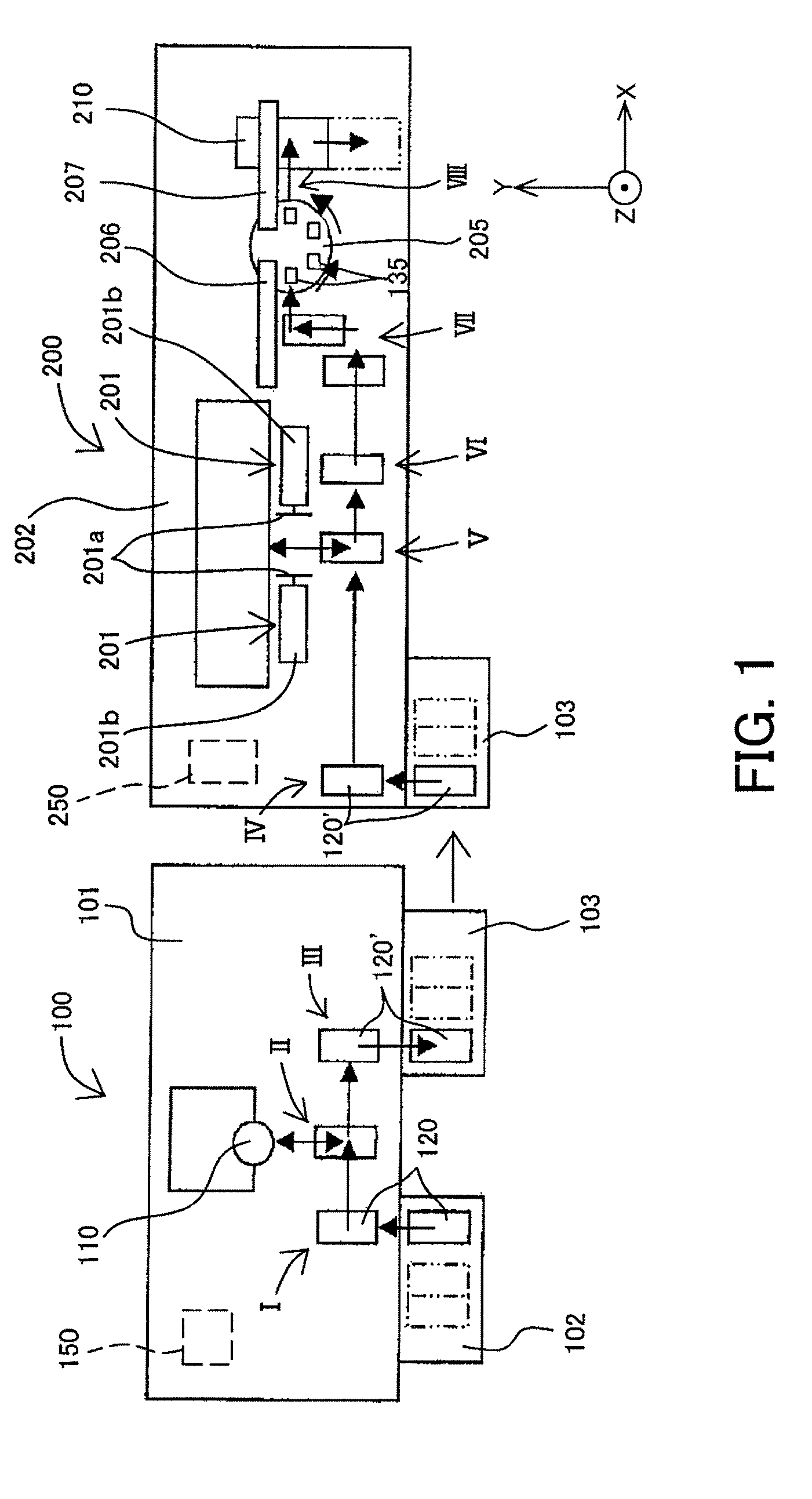Semiconductor cutting device, semiconductor cutting method, semiconductor cutting system, laser cutting device and laser cutting method
a cutting device and semiconductor technology, applied in the direction of metal working equipment, printed circuit manufacturing, manufacturing tools, etc., can solve the problems of deteriorating scanning position accuracy of laser beams, increasing the size of laser oscillators and high cost, and reducing so as to reduce the cutting section inclination
- Summary
- Abstract
- Description
- Claims
- Application Information
AI Technical Summary
Benefits of technology
Problems solved by technology
Method used
Image
Examples
first embodiment
[0076]FIG. 1 shows the configuration of a semiconductor cutting system seen from the above, which is a first embodiment of the present invention. In FIG. 1, reference numeral 100 denotes a laser cutting part constituted by a laser cutting processing apparatus, and reference numeral 200 denotes a blade cutting part constituted by a dicing apparatus.
[0077]The laser cutting part 100 includes a base 101 and a laser oscillator 110 installed on the base 101. Reference numeral 102 denotes a first substrate magazine with large quantities of semiconductor substrates 120 before laser cutting processing stored therein, and by an unshown first transport mechanism, the semiconductor substrates 120 are transported to a first position I on the base 101 from the first substrate magazine 102 one by one.
[0078]The semiconductor substrate 120 before the cutting processing is shown in FIG. 5. Here, as one of the semiconductor substrates 120, the memory card substrate is shown as an example. The memory c...
second embodiment
[0140]FIG. 21 shows the configuration of a semiconductor cutting system which is a second embodiment of the present invention. The system of the first embodiment (FIG. 1) has been described on the case where the laser cutting part 100 and the blade cutting part 200 are combined into a separate apparatus. However, in the present embodiment, the system is configured to be one apparatus having both of the laser cutting part 100 and the blade cutting part 200.
[0141]In FIG. 21, the components common with the first embodiment (FIG. 1) are attached with the same reference numerals as the first embodiment, and this will be substituted for the description thereof.
[0142]In the present embodiment, a laser oscillator 10 and two cutting blade units 201 are provided on a base 101.
[0143]The method and procedure for cutting a substrate in the present embodiment are the same as the first embodiment.
third embodiment
[0144]FIG. 22 shows the configuration of a semiconductor cutting system which is a third embodiment of present invention. In the systems shown in the first embodiment (FIG. 1) and the second embodiment (FIG. 21), after the cutting of the corner portions by the laser cutting part 100, the cutting of the straight line portions by the blade cutting part 200 is performed. In contrast to this, in the present embodiment, first, the straight line portions are cut by a blade cutting part 200, and then, the corner portions of the individualized memory card region are cut by a laser cutting part 100.
[0145]In FIG. 22, the components common with the first and second embodiments are attached with the same reference numerals as these embodiments, and this will be substituted for the description. Further, in the present embodiment, though a case is shown where the system is configured to be one apparatus provided with two blade cutting units 201 and a laser oscillator 10 on a base 101, similarly t...
PUM
| Property | Measurement | Unit |
|---|---|---|
| angle | aaaaa | aaaaa |
| Q switch frequency | aaaaa | aaaaa |
| Q switch frequency | aaaaa | aaaaa |
Abstract
Description
Claims
Application Information
 Login to View More
Login to View More - R&D
- Intellectual Property
- Life Sciences
- Materials
- Tech Scout
- Unparalleled Data Quality
- Higher Quality Content
- 60% Fewer Hallucinations
Browse by: Latest US Patents, China's latest patents, Technical Efficacy Thesaurus, Application Domain, Technology Topic, Popular Technical Reports.
© 2025 PatSnap. All rights reserved.Legal|Privacy policy|Modern Slavery Act Transparency Statement|Sitemap|About US| Contact US: help@patsnap.com



